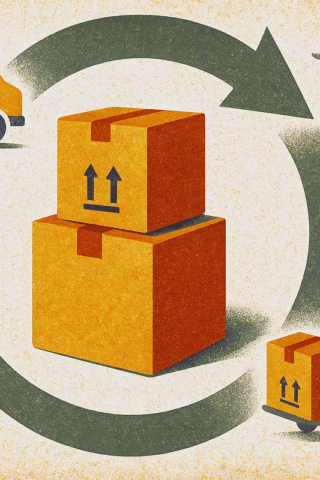Today’s businesses and OEMs face the complexities and challenges of managing technology items flowing back through the supply chain. They handle employee offboarding, technology refreshes, and disposition, often encountering obstacles and added costs.
In this blog, we’ll go over reverse logistics challenges, how to improve operations, and potential solutions you can opt for in your processes. We’ll answer important questions like:
- What is the downside of a reverse supply chain system?
- Are there advanced reverse logistics challenges to pay attention to?
- What are the benefits of leveraging the latest technologies, such as the Internet of Things (IoT), blockchain technology, and predictive analytics?
We’ll answer these questions and cover other essential subjects in the discussion below.
What is Reverse Logistics?
Let’s start with a definition to understand the challenges of reverse logistics. Reverse logistics refers to the processes involved when products or materials move from the customer to the seller, manufacturer, or disposal partner. In the technology supply chain, this can include everything from handling e-waste and reselling technology that still has life, to lease returns, recycling, and disposition of IT equipment. It’s a critical part of any business, especially in sectors where technology is used, and where sustainability is important.
Key Challenges in Reverse Logistics
Organizations face challenges such as IT returns management, its incumbent costs, handling large volumes of IT returns, and the complexities of communication and coordination when handling reverse logistics.
Here are some of the most common issues you may need to manage in your logistics processes:
- High Costs of Returns Management
One of the primary challenges of reverse logistics is the high cost of managing returns. From a dedicated IT asset manager, to communication, logistics and transportation, labor, product disposal and documentation, each step adds a layer of cost that impacts your bottom line. For businesses managing large volumes of returns, these costs can quickly add up, reducing profitability. It becomes even more of a concern if an organization has a large force of remote employees.
In order to mitigate these costs, we need to optimize processes, such as automating returns handling and leveraging logistics providers specializing in reverse logistics. Implementing better tracking systems can also help businesses reduce errors and improve efficiency.
- Handling Large Volumes of Returns
With the increase of distributed employees, remote IT equipment returns have become more frequent, and managing large volumes of returns from home offices or field sites is an ongoing challenge. Pickup and transportation, sorting, recycling, or disposing of returned items can cause bottlenecks in IT operations, where IT teams are often not equipped to handle the sheer volume of returns. We can tackle this by partnering with a provider specializing in reverse logistics.
- Complex Coordination and Communication
Coordinating reverse logistics across multiple parties— employees, warehouses, logistics providers and downstream partners—can be a logistical challenge. Miscommunications and inefficiency can result in lost items, increased return times, additional costs and potential regulatory fines if corporate or customer information is exposed. If a lack of real-time visibility into inventory and return statuses exists, it can create inefficiencies throughout the entire reverse supply chain.
Real-time data tracking and communication platforms are essential to overcome these coordination issues. We must implement cloud-based systems that allow all parties to stay connected and access real-time updates, reducing errors and improving collaboration
Environmental Impact and Sustainability
Sustainability is becoming more important for businesses as customers increasingly demand environmentally friendly practices. However, making reverse logistics sustainable poses challenges. What is the downside of a reverse supply chain system? The environmental impact can be significant if returns aren’t managed properly, leading to e-waste and environmental harm.
Businesses can address this by integrating green logistics practices into their reverse supply chain. We can focus on refurbishing returned products for resale or reuse, implementing recycling programs, ensuring e-waste is properly handled, and reducing carbon emissions through more efficient logistics planning.
Managing the 5 R’s of Reverse Logistics
Businesses manage different types of reverse logistics flows, including returns, reselling, repairs, replacements, and recycling—each with unique challenges. Managing all five efficiently can be daunting, especially with remote returns from all over the country and downstream service providers handling different parts of reverse logistics. Many companies struggle to optimize each of these areas due to a lack of specialized infrastructure or processes.
Our team at Onepak can streamline this process with our global online logistics platform, connecting businesses and consumers with a network of providers who can reuse, repair, resell, or recycle their obsolete IT products. Implementing specialized software solutions can also help us efficiently categorize and route products with carbon neutral results.
Advanced Reverse Logistics Challenges
As mentioned, inventory management and transportation, data management, and lack of visibility are some of the biggest reverse logistics challenges.
- Data Management and Lack of Visibility
Tracking returned products as they move back through the supply chain is a significant challenge. Without real-time visibility into product status and location, managing returns can become chaotic, leading to delays and additional costs.
We can address this using advanced technologies like IoT, blockchain technology, and AI to improve tracking and data accuracy. Predictive analytics can also help businesses make more informed decisions about managing returns and reducing unnecessary costs.
- Return Process Complexity
For organizations whose workforce uses technology, remote employee returns, equipment refreshes, product end of life, repair issues and lease returns introduce an added layer of complexity. Handling these efficiently is critical, as delays or errors can result in loss of productivity or even loss of protected data.
Businesses should develop standardized processes for handling IT returns, leveraging reverse logistics partners to ensure quick and accurate equipment returns.
Solutions for Overcoming Reverse Logistics Challenges
Platform technology that allows for logistics scheduling, supply chain vendor management, and tracking IT equipment are key when tackling reverse logistics challenges.
- Implementing Technology Solutions
Real-time tracking systems, technology ecosystems, and automation are key to addressing many reverse logistics challenges. These technologies help streamline returns, provide better data insights, and improve efficiency.
- Outsourcing to Logistics Providers
Many businesses turn to specialized logistics providers for reverse logistics. These providers specialize in the returns process, helping businesses reduce costs, improve processing speed, and focus on their core operations.
- Product Takeback Programs
A sophisticated, cloud-based platform that automates and centralizes the entire reverse logistics process can assist electronics OEMs with reverse logistics for product takeback programs. These platforms can offer real-time tracking, detailed reporting, and accountability for each shipment, making the takeback process more efficient and transparent.
The Future of Reverse Logistics
Businesses that invest in critical areas such as sustainability, automation, and technology ecosystems will be better positioned to reduce costs, improve communication, and remain competitive. If your business faces reverse logistics challenges, our team at Onepak is here to help. Contact us any time.
We specialize in streamlining the returns process, reducing costs, and improving efficiency. Onepak equips your business with a logistics platform with dynamic dashboards, logistics routing, order management, and reporting to streamline reverse logistics operations. Let’s work together to ensure your processes remain smooth and sustainable. Request a demo today!








